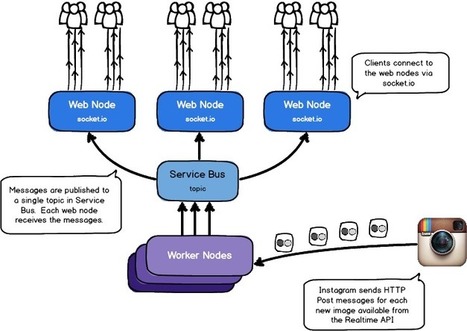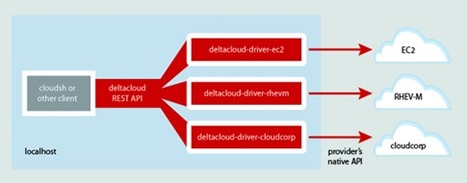 Your new post is loading...
 Your new post is loading...
In some recent blog posts, we’ve explained why we believe it’s crucial to adopt a four-tier application architecture in which applications are developed and deployed as sets of microservices. It’s becoming increasingly clear that if you keep using development processes and application architectures that worked just fine ten years ago, you simply can’t move fast enough to capture and hold the interest of mobile users who can choose from an ever-growing number of apps.
Switching to a microservices architecture creates exciting opportunities in the marketplace for companies. For system architects and developers, it promises an unprecedented level of control and speed as they deliver innovative new web experiences to customers. But at such a breathless pace, it can feel like there’s not a lot of room for error. In the real world, you can’t stop developing and deploying your apps as you retool the processes for doing so. You know that your future success depends on transitioning to a microservices architecture, but how do you actually do it?
Wazstagram is an experiment with node.js on Windows Azure and the Instagram Realtime API. It uses node.js, socket.io, and service bus to create a scalable window into Instagram traffic across multiple cities.
If you still haven’t found the time to learn how to install, configure, and maintain a database, you might be interested in a cloud solution that promises “zero management.” Xeround sells itself as the “zero-management database.” Managing databases consumes thousands of hours every year, becoming yet another time sink to sys admins and developers alike. Management includes everything from installation through upgrades, checking on server health and disk space, and scaling and managing these things at scale – something that every one of us could learn, given a few books and the time if we could find it. Fully managed databases (DBs) aren’t new, and Xeround isn’t the first, but it has focused on the things that cause plenty of pain. Keeping a DB running and scaling it. After housing, powering, and securing the physical machines, configuring them is the next task that can distract from actually building an app. Although you might have edge case requirements that need specially honed and tweaked database servers, chances are … you don’t really. In most cases, you can do a lot with a good standard config file and focus your efforts on the architecture of the app using these standard configs. Once you’ve given up your grip on the config files and the SSH into the box, you can focus on the app again. It’s okay to make apps and not be a slave to sys admin duties all the time.
Following your awesome feedback about our post from March, Free Cloud Services for Application Developers, the Xeround team put our heads together to produce an expanded list of 43 free cloud resources that can make life easier for application developers. All free of charge. Everything we do focuses on freeing up your IT resources and need to invest in any special tools or expertise, so that you can concentrate on what you do best – cranking out kick-ass code. Enjoy! Covered areas include : - Cloud IDEs - Source Code Management - Issue Tracking - Cloud Databases and Open Source DBs - CMS - Payment Gateways - IaaS/PaaS/Code Hosting - Load Testing - Monitoring - Knowledge Base/Helpdesk - Web Analytics
One of the questions we always get asked at meet-ups and conversations with other engineers is, “what’s your stack?” We thought it would be fun to give a sense of all the systems that power Instagram, at a high-level; you can look forward to more in-depth descriptions of some of these systems in the future. This is how our system has evolved in the just-over-1-year that we’ve been live, and while there are parts we’re always re-working, this is a glimpse of how a startup with a small engineering team can scale to our 14 million+ users in a little over a year. Our core principles when choosing a system are: - Keep it very simple - Don’t re-invent the wheel - Go with proven and solid technologies when you can
Puppet Enterprise 2.0 is an enhanced open source management platform for the cloud and on-premise servers that features new cloud provisioning, change monitoring and management orchestration from a sole console and new GUIs. Puppet doesn’t just allow customers to deploy workloads in the cloud or enterprise. It tells virtual machines what to do. Puppet Enterprise 2.0 is available on October 21, Customers may download and manage up to 10 nodes free of charge.
Cloud computing isn’t just about outsourcing IT resources. We explore ten benefits IT architects and developers will realize by moving to the cloud.
The goal of Sencha.io services is to provide common application functionality as cloud services so that application developers (particularly mobile application developers) don’t have to reinvent the wheel every time they want to make an app. Our first two cloud services solve two common problems for app developers – resizing images for different mobile screen size/resolution combos, and making offline and collaborative data synchronization easy.
This list only includes "Platform as a Service" products. Not all services listed are available to everybody yet. You can also follow them on twitter through this twitter list: http://twitter.com/#!/peakscale/paas/membersSupported technologies are : PHP, Python, Ruby, Java, Node JS, .NET, Perl, Ringo JS, Javascript
Just targeting one mobile platform is not good enough anymore but building apps for lots of different mobile phone platforms could be a long and tedious task. Every smartphone platform has its own software development kit (SDK), these will need a developer to use different languages to be able to work with them all. You could easily end up with five or six code bases in order to reach a decent number of devices. So what to do if a mobile web site isn't seen as an acceptable alternative? Fortunately mobile apps and mobile web sites are two ends of a spectrum of possibilities. Sitting somewhere in the middle is PhoneGap Build, a service that lets you develop using Javascript, HTML and CSS and then builds apps for five platforms in the cloud.
|
Mis au point par l’équipe à l’origine du PaaS DotCloud, « Docker est un système de packaging qui permet de prendre n’importe quel code source, n’importe quelle application et de l’envelopper, avec toutes ses dépendances, dans un objet unique, « self-contained », que l’on peut déplacer et faire tourner sur n’importe quel serveur, n’importe où sur la planète », explique Solomon Hykes, le diplomé d’Epitech en 2006 à l’origine de DotCloud et qui vit désormais en Californie, là où Docker vient d’être gratifié de 15 M$ de capital-risque qui s’ajoutent au 11 M$ déjà accordé à DotCloud depuis 2010.
Trop beau pour être vrai ? Pourtant, Docker permet de créer de tels containers sur toutes les principales distributions Linux depuis fin novembre 2013. Il est déjà utilisé pour gérer les développements de sociétés à la pointe de la technologie comme eBay. Google l’a intégré à son IaaS GCE et il a donné naissance à CoreOS, une distribution Linux dédiée aux datacenters conçue pour ne recevoir que des applications en containers. Quant à Yandex, le moteur de recherche numéro un en Russie, il lance Cocaine (*), une PaaS open source qui intègre aussi Docker. Docker est également embarqué dans le projet OpenStack, tant au niveau traitement (Nova) qu’orchestration (Heat).
OpenMobster, provides a complete end-to-end Sync solution for your mobile apps. The infrastructure consists of a Cloud Server that integrates with backend Enterprise services. On the device side, this data is accessible through the MobileBean API included in the device SDK. This way you can focus on writing the business logic for your mobile app while the low-level synchronization details are automagically taken care of by OpenMobster.
In OpenMobster, synchronized data is replicated across devices and platforms. You could have multiple devices registered with the Cloud. Any data changes on one device will be automatically pushed to other devices. Data Replication is built directly into your app. As a developer you don't have to do anything special or code to a particular API. Data replication is one of the synchronization services you get out of the box.
The Push Engine is tightly integrated with the Sync Engine. With this, if there is any new data coming from the Cloud, it is pushed automatically to the device. The user will then receive a "You have new data" like message in the phone's notification area. This feature enables real time updates from the Cloud to the device without using the polling technique.
As the world shifts to computing on the cloud , or what my non tech friends call, lots of servers connected to the internet, APIs become increasingly the lingua franca or working language to communicate to and fro from these clouds. Storage in the cloud has been of the earliest use cases and one which has increasingly made sense to create secure backups at a much cheaper rate. So here is a collection of Cloud Storage APIs, as far as possible they are RESTful . Please note I am referring only to some of the biggest players in the cloud storage API space- and you may find others. But since the article is aimed at enterprise readers willing to park confidential content on the cloud, this is a list of the biggest cloud storage providers which offer API access.
The rise of cloud computing over the past few years has been incredible. Unfortunately, many still do not see the interest or do not comprehend its importance.
This is not a post about cloud computing and its benefits, but rather a refresher about understanding some basic rules of scalability and how to get started with building scalable apps while keeping in mind that most people and companies have limited budgets.
The concept of shared-nothing architectures is well known in the scalability community — if such a thing even exists — but it seems to be frequently forgotten when it comes to building web apps.
SOA Software announced today the availability of Atmosphere Cloud, the cloud-based version of its award winning Enterprise API Management solution. Combined with the on-premises ‘behind the firewall’ deployment option that was announced in June, Atmosphere customers can now choose how they want to configure and deploy their API Management environment.
Atmosphere brings together API providers and Application developers in an integrated Enterprise API Management Community. It is a connecting point where APIs can be published, promoted, and managed in a secure, scalable environment. API providers can create and manage their own developer community, or just plug into the existing community. Creative people can discover and harness enterprise APIs blending them with complementary APIs from partner companies. Atmosphere provides a social environment where developers can work together, share ideas, and support each other in new and productive ways.
More info here : http://atmos.phe.re/
Managing cloud-based VMs isn't easy. Tools from IaaS vendors are rudimentary and proprietary, while integration with enterprise management consoles is complex. SaaS management software is closing the gap with new services able to manage systems in multiple clouds alongside internal VMs.
Message-oriented Cloud Middleware (Cloud Messaging)
The logical evolution of traditional message-oriented middleware solutions: making the technology available as a service, reducing complexity, and eliminating the need for new infrastructure.
Cloud messaging is not simply the hosting of traditional solutions in-the-cloud. It is the re-architecting of a core, complex platform technology into an easy-to-use service. This is Linxter.
Already available for Android, WP7, .NET and Java. iOS support coming this summer.
Experiment report on setting up a frontend Django application and several workers communicating with each other using Celery messaging and a Redis backend.
The DeltaCloud API provides a single API interface to work with multiple cloud computing providers.
With the DeltaCloud API you can start an instance on an internal cloud, then with the same code start another on Amazon EC2 or Rackspace..
In a blog post following a recent report by the 451 Group, Matthew Aslett, a senior analyst for the research firm, defines a new breed of SQL database-related products he labels as “NewSQL”.
According to the 451 Group, NewSQL refers to “various new scalable/high performance relational database products and services which are designed to bring the benefits of the relational model to distributed architectures or to improve the performance of relational databases…”
|



 Your new post is loading...
Your new post is loading...



















